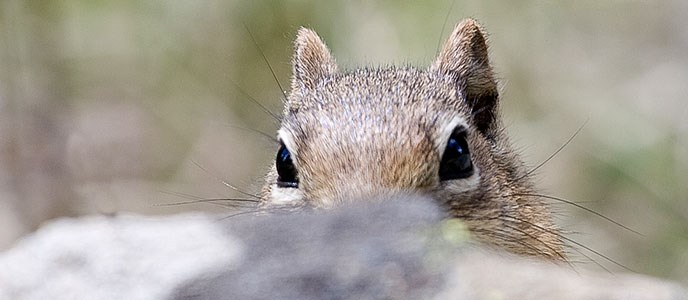
NPS Curiosity defines the squirrels of Rocky Mountain National Park. They are brave yet skittish at the same time. There are 10 species of squirrels in the park. All are diurnal, meaning they are active during daylight hours. You are likely to see one of these small mammals anywhere in the park. Meet some of the more common squirrels below.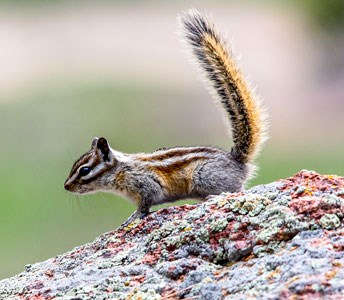
NPS Least ChipmunkThese are the smallest squirrels in the park. Their body ranges from less than seven inches to nine inches long (including the tail). The most apparent feature is the five stripes on the back and sides of their small bodies. Two of the stripes extend onto the head. Only the chipmunk as stripes on its face. It can also be identified by its rapid nervous movements. They have large fur-lined cheek pouches that they use for carrying nuts and seeds. This species of chipmunk has the largest range of habitat, living from the lowest park elevations to timberline and above. The prefer rocky areas and burrow beneath rocks, logs, shrubs and other shelters. Least chipmunks are not true hibernators. They are in a state of torpor from which they occasionally arouse to feed on stored food. Breeding takes place shortly after this period, and the gestation period takes four to five weeks. Typically there are five or six young which do not leave the nest until they are about four weeks old. 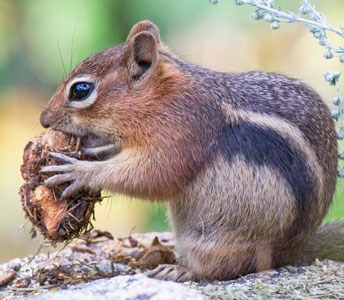
NPS Golden-Mantled Ground SquirrelThis ground squirrel is often mistaken for a chipmunk because of its resemblance. However, it is larger and has no stripes on its head. The tail is also shorter. On its neck and shoulders is a russet to golden "mantle." It also has cheek pouches for carrying food. This squirrel's habitat in the park also extends from low elevations to well above treeline among rocks and near the edges of woodlands. They are quite brazen as they beg for peanuts and morsels from picnicker and hiker lunches, but please keep them wild by not feeding them. By late summer, heavy deposits of fat have been stored in their bodies. They move into hibernation with the first snows and colder temperatures. They breed shortly after their hibernation period. Female gestation takes about four weeks giving birth to five young on average. Body stripes start appearing after only about four days. 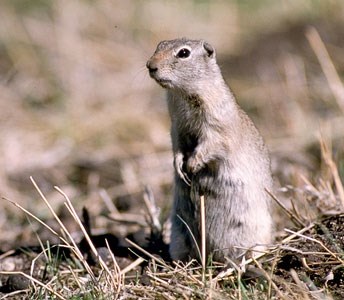
NPS Wyoming Ground SquirrelWyoming ground squirrels are medium-sized squirrels averaging between 10 and 12 inches in length. They are a solid, brownish gray color with a lighter belly. They have no stripes. These squirrels often sit in alert upright poses. They like open country where the soil is well drained so that their burrows remain dry. They often leave piles of debris downslope from their burrows. They may live between 6,000 and 12,000 feet in elevation. In addition to their favored diet of foliage, they may feed on remains of other ground squirrels along roads and highways. During mid-summer their food begins to convert to fat to sustain them through their winter hibernation period. This begins when they have reached a critical amount of fat, regardless of external environmental conditions. This usually occurs in late August or early September. Soon after hibernation, these ground squirrels breed. The female gestation period is a little over four weeks with a brood of five to six young on average. They are weaned by five weeks and then appear above ground by early June. 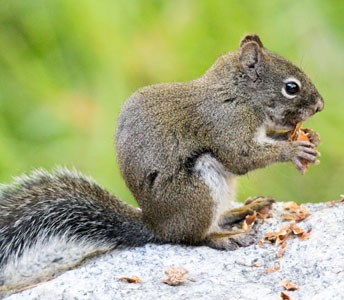
NPS Pine Squirrel or ChickareeThis is the smallest tree squirrel with an average length of about a foot long. Its coloration ranges from rust-red to gray, and its tail is outlined with a broad black band edged with white. It is an extremely vocal squirrel, chattering, stomping its feet and scolding any intruders to get them to leave. It lives mostly in forests of middle elevations in the park. It favors the spruce-fir, Douglas-fir, or lodgepole pine areas to that of the ponderosa pine. It requires cones for food and prefers damp and cool areas to store pine cones. Chickarees are very territorial and may defend their areas with physical force. They leave piles of litter which can reach 10 yards across and 32 yards deep. Cones are stashed in this debris called a midden. Chickarees are active during the day and then retire to their nests at night. Nests may be on the ground, on a tree branch, or inside hollow trees. Chickarees usually mate in April. The gestation period is about 40 days with one to six young being born. They do not leave the nest until they are about one-third grown. 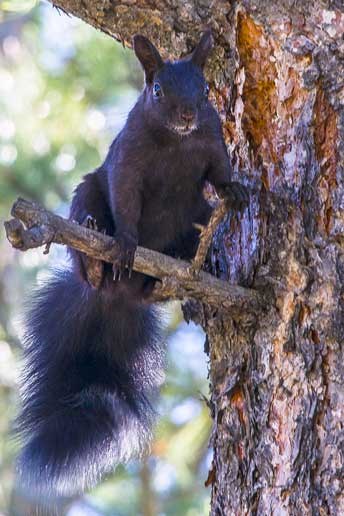
NPS Abert's SquirrelThese are the most distinct squirrels in Rocky with their conspicuous ear tufts and long, full tails. These squirrels are fairly large and heavy-bodied getting up to 23 inches in length. The majority of the individuals in the park are dark gray to black. These squirrels are principally found on the eastern edge of Rocky Mountain National park at elevations of approximately 8,500 feet. They prefer ponderosa pine woodlands, but their population is sporadic. They feed on the ponderosa pine cones but do not store them in appreciable amounts. They build elaborate year-round nests in ponderosa pine trees. They are active during the day and return to their nests at night. Their territories are much larger than that of other squirrels. During the mating season of March and April, females may entice several males to start elaborate chases before choosing a mate. Litters of two to five young are born after a gestation period of about seven weeks. They are not weaned until almost 19 weeks of age. |
Last updated: May 5, 2018
